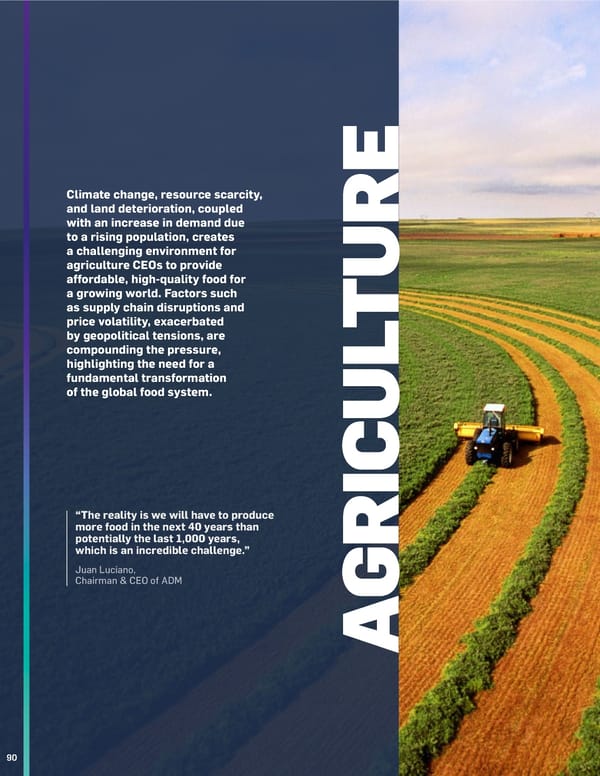T H E 1 2 T H U THE MOST PRESSING CHALLENGES AGRICULTURE CROSS INDUSTRY N I T E D N A 1 CLIMATE CHANGE 2 INFLATION & PRICE VOLATILITY 3 TRADE REGULATION T I O N S G L 26% 2% O 21% B A L C O 59% 59% 57% M 52% P E 33% 31% A C T - A C C Climate change, resource scarcity, E N T U and land deterioration, coupled R R CURRENT LANDSCAPE E C with an increase in demand due E O S to a rising population, creates T TOP RESILIENCE ACTIONS FOR AGRICULTURE CEOS U D a challenging environment for Y agriculture CEOs to provide of CEOs are of CEOs are of CEOs are upskilling or enhancing engaging in U 81% 73% 73% affordable, high-quality food for reskilling their workforce for sustainability data collection long-term strategic a growing world. Factors such the future labor market capabilities across their partnerships as supply chain disruptions and value chains price volatility, exacerbated T The agriculture industry operates on the front lines of the climate crisis, facing droughts, floods, and extreme weather patterns, along by geopolitical tensions, are with biodiversity loss, arable land deterioration, and growing water scarcity. All these factors impact daily operations, not only damaging compounding the pressure, crops, but also straining food system infrastructure. Agriculture CEOs are looking to technology to inform their decision making, starting by focusing on digitization and real-time data collection to identify risks and be more efficient in their use of natural resources. highlighting the need for a L As Sanjay Gupta, MD and CEO of National Commodities Management Services Limited (NCML), describes, “Value chain concerns have fundamental transformation been mitigated to some extent by advancements in technologies, such as internet of things, drones, mobility, cloud computing, big data, remote sensing, machine learning and logistics in agriculture and agri-bots which are playing a transformative role in converting of the global food system. traditional agriculture into data-driven, precision farming for generating sustainable profits.” U Connected technologies, such as drones or blockchain-based solutions, are transforming the industry to be able to react to impacts in real time. However, for a large-scale transformation, companies are cognizant that they must upskill their workforce on these new ways of working and engage with the smaller farmers who make up the majority of the supply chain. CEOs are, therefore, investing in C strengthening their partnerships with suppliers to enhance visibility and support the adoptions of digital and sustainable practices. WHERE IS THE INDUSTRY GOING? I TOP SUSTAINABILITY PRIORITIES FOR AGRICULTURE CEOS “The reality is we will have to produce of CEOs are of CEOs are of CEOs are constructing protecting and lowering more food in the next 40 years than 56% 48% 48% potentially the last 1,000 years, R a responsible supply chain restoring biodiversity GHG emissions which is an incredible challenge.” The future of agriculture calls for healthier, sustainable practices that create more food to satisfy the needs of rising populations with Juan Luciano, less impact on the natural environment. While digital practices are a strong first step, a wide-scale transformation is needed. Bold Chairman & CEO of ADM actions, such as adopting regenerative agriculture practices that take into consideration the entire ecosystem, are necessary to this G transformation. Regenerative practices not only reduce soil erosion and water usage, but also help protect and restore biodiversity. TRANSFORMATIVE INNOVATIONS A Regenerative agriculture practices 75% Seed technology 71% Digital agriculture 67% Advanced aquaculture 52% Controlled environment agriculture 35% HIGH IMPACT MODERATE IMPACT LOW IMPACT NO IMPACT 90 91
 Accenture CEO Study United Nations Global Compact Page 89 Page 91
Accenture CEO Study United Nations Global Compact Page 89 Page 91